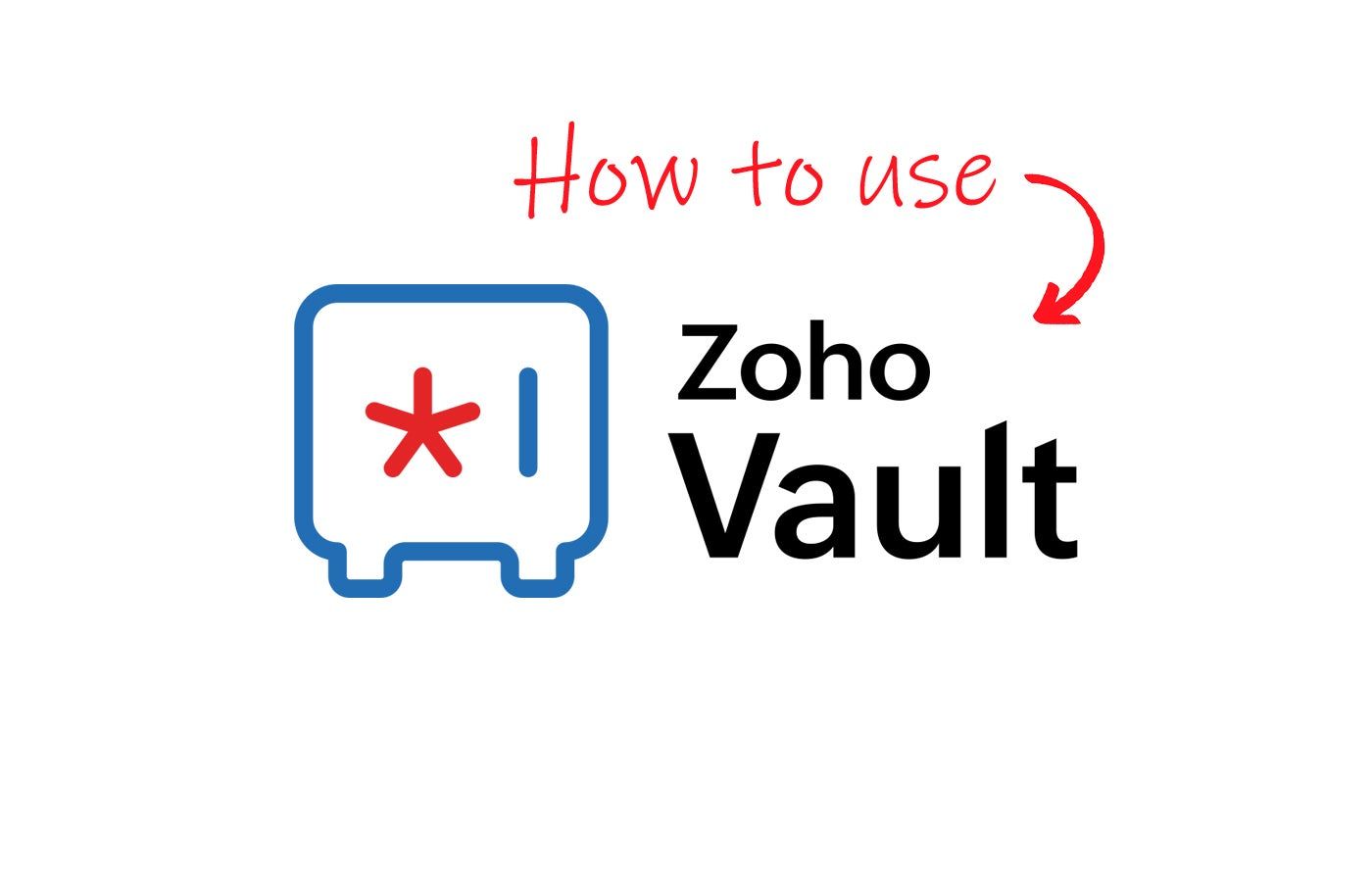Zoho Vault is a business-focused password manager that provides convenient monitoring tools for administrators of large organizations.
In this article, we explain how to set up and use Zoho Vault. We also answer some frequently asked questions about Zoho Vault and its feature set.
1
Dashlane
Employees by company size
Micro (0-49), Small (50-249), Medium (250-999), Large (1000-4999), Business (5000+)
Micro (0-49 employees), small (50-249 employees), medium (250-999 employees), large (1000-4999 employees), enterprise (5000+ employees)
Micro, Small, Medium, Large, Enterprise
Characteristics
Automated provisioning
2
ManageEngine ADSelfService Plus
Employees by company size
Micro (0-49), Small (50-249), Medium (250-999), Large (1000-4999), Business (5000+)
Any size of company
Any size of company
Characteristics
Multi-factor authentication, password management, reporting and analytics, and more
How to set up and use Zoho Vault
1. Decide on a Zoho Vault subscription
Zoho Vault has a free version and three paid tiers. Its free version is good for basic use as it offers unlimited password storage. However, useful features like password sharing and password breach alerts can only be accessed through a paid plan.
In our hands-on review, Zoho Vault received a score of 3.9 stars out of 5. Check out our full Zoho Vault review here.
Their premium subscriptions are divided into Zoho Vault Standard, Professional, and Enterprise.
Figure A
Here's a brief summary of the differences between the three:
- Standard – Includes role-based and password sharing permissions.
- Professional – Standard features, shared folders, breached password alerts and emergency access.
- Company – Professional features, SSO for cloud applications, SIEM integration, access control features such as time-limited access to passwords and a password prompt release mechanism.
Fortunately, Zoho Vault provides access to 15-day free trials for all of its plans. They also do not require any credit or payment information to test their software.
I highly recommend taking one of these free 15-day trials first and opting for the plan that fits the size of your business. To access a free trial, simply click on one of the Try now buttons on the subscription of your choice.
For this demo, I chose to try the Enterprise edition of Zoho Vault for free.
2. Zoho Vault Installation and Configuration
Once you've chosen a plan, you'll be asked to create a Zoho account. Please note that this is different from the master password and account you will eventually create for your organization's vault. That being said, be sure to save your credentials for this Zoho Vault account.
After creating a Zoho account, it asked me whether my organization already had Zoho Vault or not. I chose No. I was then redirected to Account creation page, where I was asked to enter my organization name and master password.
Figure B
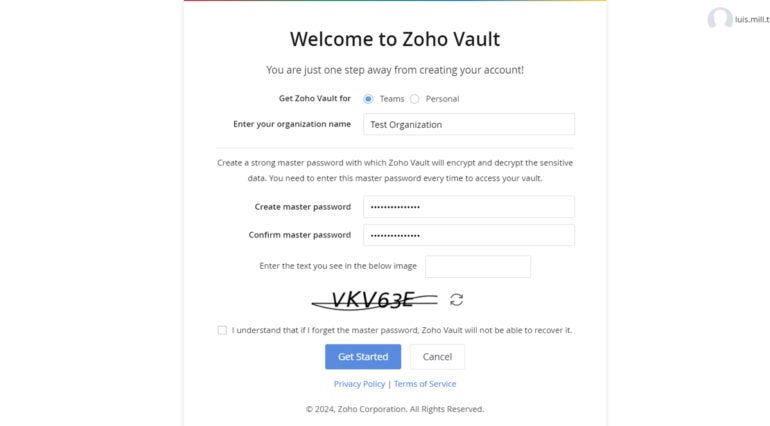
This is where I wrote my master password. This is technically the only password we need to type ourselves and serves as our primary key to access the entire organization's vault. After completing the necessary fields, I clicked Begin and was redirected to the main Zoho Vault dashboard.
Once there, I received a welcome message from Zoho Vault and an invitation to take a brief tour of the product.
Figure C
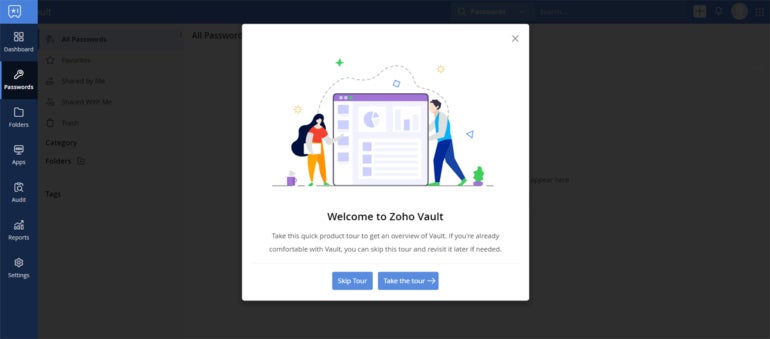
I recommend taking the short tour as it introduces you to some of the important menus and buttons within the app. After the tour, I was presented with a blank Zoho Vault dashboard.
Figure D

While the password manager will work as advertised, I recommend downloading the Zoho Vault browser extension as well. This makes saving and auto-filling passwords on websites much easier as you can access Zoho Vault right from your browser.
Figure E
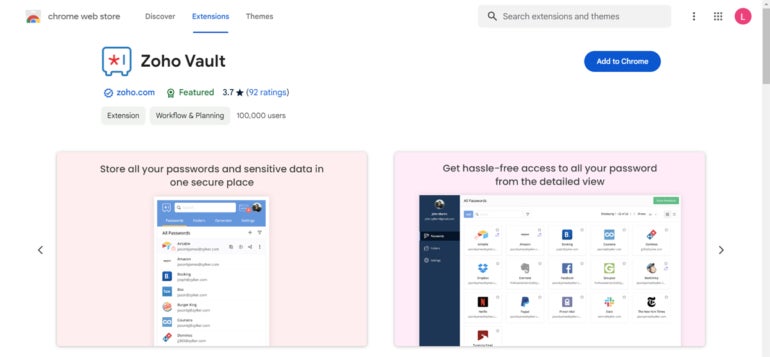
As a Chrome user, I went ahead and downloaded Zoho Vault from the Chrome Web Store. Zoho Vault is also available in Safari, Firefox, Edge, Vivaldi, Brave, Opera and Ulaa.
Once I installed the browser extension, I was ready to save my first login with Zoho Vault.
3. Save your first login with Zoho Vault
The best way to learn how to save account logins with Zoho Vault is to create a real account. To demonstrate this, I created a new Amazon account.
On the Amazon account creation page, the Zoho Vault logo appeared in the password field.
Figure F
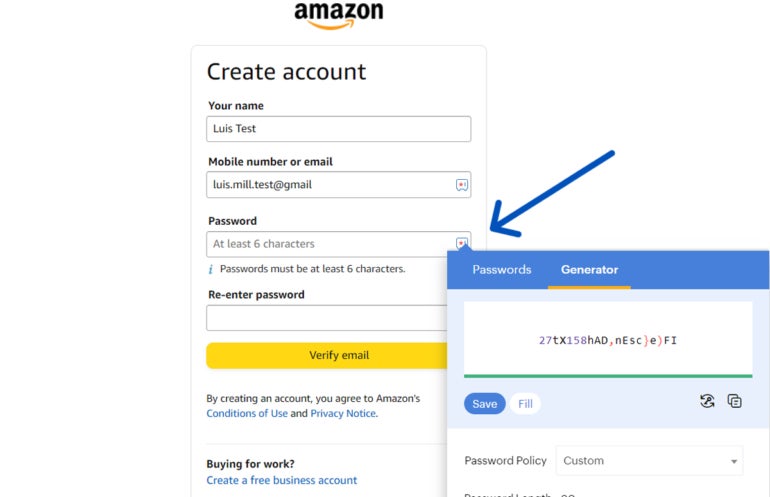
When I clicked on the logo, the Zoho Vault password generator appeared.
Figure G

Zoho's password generator allows you to generate a random password of up to 99 characters and a minimum of 12. You can also set it to follow a moderate, less strict, strong, or custom password policy or strength. In this case, I chose Custom and set it to my preferred settings.
I have clicked Save and was redirected to the main Zoho Vault web portal. I was asked to verify my new Amazon account details and clicked Save for the last time.
Figure H
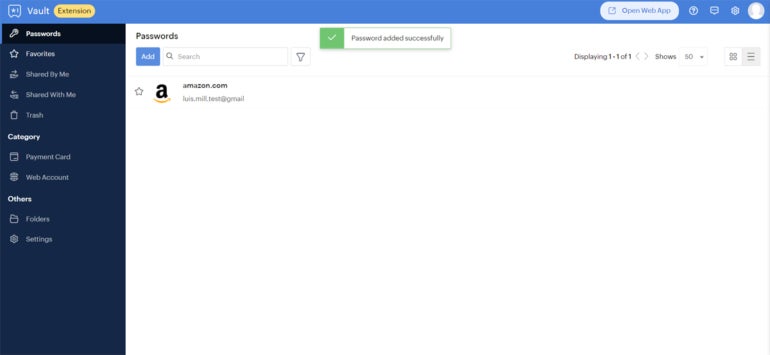
At this point, the new Amazon account I created can now be found in the main Zoho Vault dashboard.
Zoho Vault FAQ
Is Zoho Vault free?
Yes, Zoho Vault has a free version in addition to its paid plans. Its free version allows unlimited password storage and access to unlimited passwords. You also get its password generator, save and auto-fill passwords, and security panel.
With the free version, you miss out on more advanced features like password sharing, cloud backup, shared folders, emergency access, and Google Workspace and Microsoft 365 integration, which you can only find in a paid Zoho Vault subscription.
Priority customer support, including email, phone, and remote support, is also available only on paid plans. Zoho Vault free users only get basic email support.
What if Zoho Vault is not working?
If you have any problems with Zoho Vault, you can visit their official help page, which contains their extensive knowledge base articles.
For more complex issues, you can submit an online form through their official site. Contact Us page. You can also send a support email or make a call to one of their support numbers.
Right now they have numbers for the United States, India, the United Kingdom and Australia and are available 24 hours a day, five days a week.
What operating systems does Zoho Vault support?
Zoho Vault is available for Windows, MacOS and Linux. It also has an official mobile application on iOS and Android.
For browsers, Zoho Vault is compatible with Chrome, Edge, Firefox, Safari, Vivaldi, Brave, and Opera.
How do I use Zoho Vault in Chrome?
You can use Zoho Vault in Chrome by downloading the official browser extension from the Chrome Web Store. From there, you can pin it to your Chrome toolbar and easily access your saved logins and the Zoho Vault password generator.
I highly recommend downloading the browser extension and using it in conjunction with the Zoho Vault web portal.
What multi-factor authentication (MFA) options does Zoho Vault offer?
Zoho Vault offers passwordless logins like YubiKey, Passkeys, Windows Hello, and TouchID. It also has its own ZohoOneAuth MFA app as a second factor option.
Paid users have access to Microsoft 365 and Google Workspace authentication. Zoho Vault Enterprise users also have access to AD/LDAP, Azure AD, and SAML 2.0 authentication.
What we think of Zoho Vault
In our full review, Zoho Vault received a rating of 3.9 out of 5 stars. We highlight its business-oriented features, such as its reporting capabilities and its security dashboard.
While we found that Zoho Vault could improve its handling of unencrypted user data, its generous 15-day free trial for all its plans and its administrator-focused features make it at least worth a try. This is especially true if you are a manager of a larger organization or business.
If you want to learn more, read our full Zoho Vault review.

